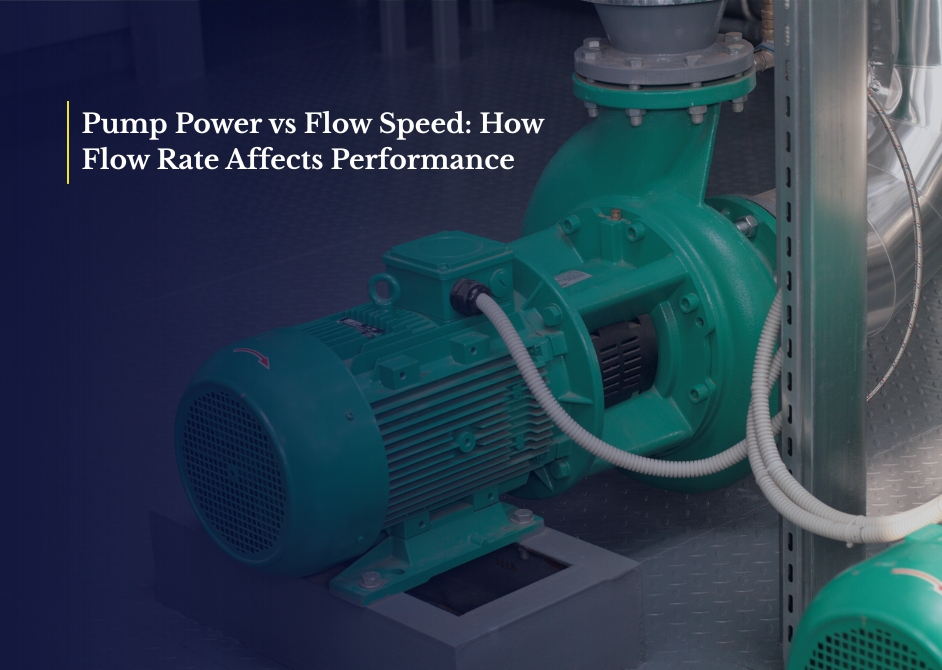If your plant runs on centrifugal pumps, you’re already tracking flow rates, pressures, and energy costs. But one metric often gets overlooked until problems show up on your utility bill or the maintenance log: the relationship between pump power and flow speed.
According to the U.S. Department of Energy, pumps account for nearly 25% of industrial electricity consumption, and much of that waste stems from improperly matched systems.
A mismatch between how fast your pump moves fluid and how much power it consumes can lead to:
- Oversized motors draining excess energy
- Undersized systems running hot and failing early
- Unstable performance when process conditions shift
And in industries like chemical, sugar, or fertilizer, where fluid properties change across batches and seasons, understanding this link becomes essential.
In this guide, we’ll break down how flow rate impacts power, what the data means for your day-to-day operations, and how to make smart decisions that keep your pumps efficient, your energy bills lean, and your system running steady.
Key Takeaways
- Pump power and flow speed are closely linked; increasing flow rate usually increases power consumption, but not linearly.
- Flow rate is the volume of fluid moved per unit time and is influenced by pump design, system resistance, and fluid properties.
- Oversized or undersized pumps lead to energy waste, premature failure, or unstable performance.
- Monitoring flow and power together helps optimize pump selection, reduce electricity costs, and extend equipment life.
- In high-variability industries like sugar, chemical, or fertilizer, understanding this relationship is key to staying efficient across different process conditions.
What Is Flow Rate in Pumps?
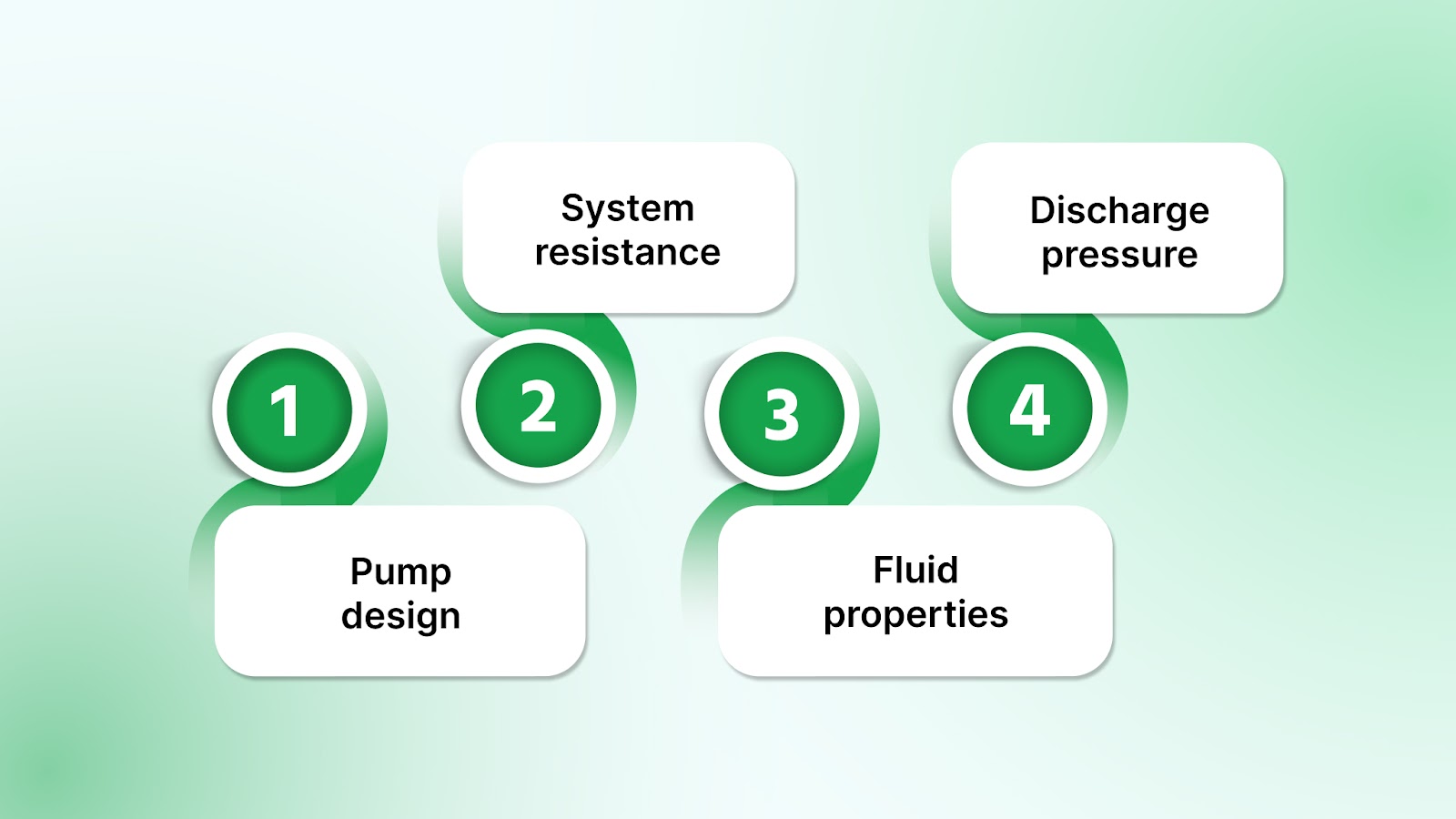
Flow rate, also called volume flow rate, is the amount of fluid a pump moves per unit of time. It’s usually measured in cubic meters per hour (m³/h), liters per second (L/s), or gallons per minute (GPM), depending on your plant’s standards.
It answers the question:
“How much fluid is being pumped through the system, and how fast?”
Flow rate is influenced by several factors:
- Pump design: Impeller size, shape, and speed
- System resistance: Piping length, bends, and diameter
- Fluid properties: Viscosity, density, and temperature
- Discharge pressure (Head): The pressure the pump must overcome to move fluid
Understanding your pump’s flow rate is more than just a design spec—it’s directly linked to how much power the pump will consume and how efficiently it will operate under changing conditions.
Quick Fact:
For centrifugal pumps, as the flow rate increases, the power demand also increases, but not in a straight line. This non-linear relationship is why even small increases in flow can lead to much higher energy use.
Understanding Pump Power
Pump power is the amount of energy a pump needs to move fluid through a system. It’s typically measured in kilowatts (kW) or horsepower (HP), and it depends on two main things:
- How much fluid you’re moving (flow rate)
- How much resistance the pump needs to overcome (head pressure and friction)
But the total energy used isn’t just about pushing fluid. It also includes mechanical and electrical losses from motor inefficiencies, transmission losses, and other system friction points.
The Power Equation
To understand how flow affects power consumption, consider the hydraulic power formula:

Where:
- ρ = Density of fluid (kg/m³)
- g = Gravitational constant (9.81 m/s²)
- Q = Flow rate (m³/s)
- H = Head or discharge pressure (m)
This equation shows a direct relationship between flow rate (Q) and power. As flow increases, power does too, but because of friction and inefficiencies, the increase is often steeper than expected.
Real-World Impact
A small bump in flow, say, to meet rising demand, can cause a disproportionate spike in power draw. That’s why:
- Oversizing pumps often leads to higher energy bills
- Undersizing them causes overheating and shortens lifespan
In plants that run 24/7, this scaling effect adds up quickly. Understanding this relationship helps you make better sizing decisions, select motors with the right margins, and keep overall system performance in check.
Tip: Always evaluate both flow and head when calculating pump power, not just one or the other. Focusing on flow alone can lead to underestimating total energy needs.
How to Calculate Pump Power Based on Flow Rate
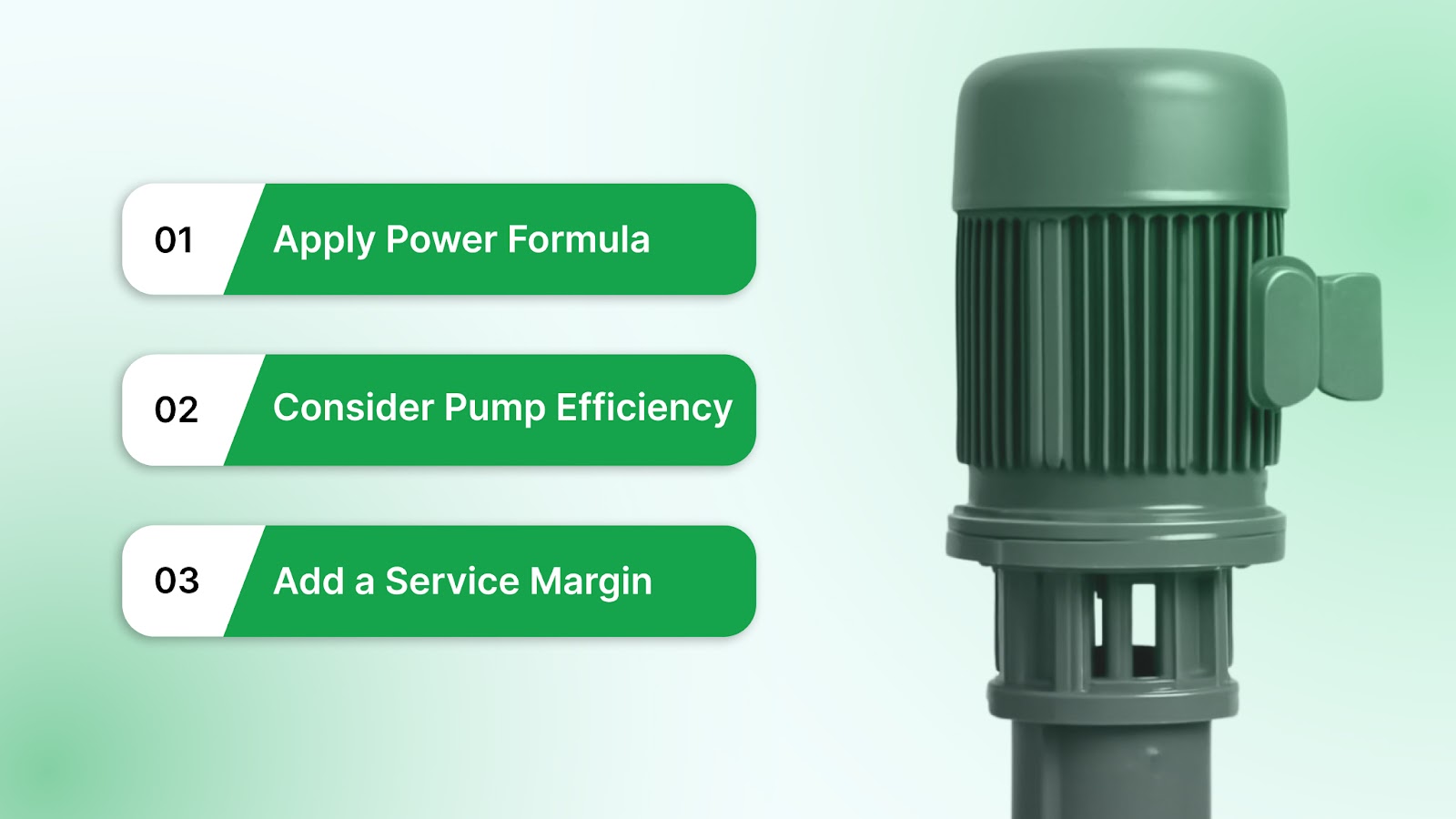
Once you understand the relationship between flow rate and power, the next step is applying that knowledge in your daily operations—whether you’re sizing a new system or troubleshooting an underperforming one.
1. Use the Hydraulic Power Formula
Earlier, we looked at how flow rate, head, and fluid density influence pump power. That same formula gives you the theoretical power (in kilowatts) required to move fluid through your system.
To calculate it, you’ll need:
- Flow rate in cubic meters per second (m³/s)
- Head in meters (m)
- Density of the fluid in kg/m³
If your team already tracks these values, you can estimate power consumption quickly and spot potential inefficiencies.
2. Account for Pump Efficiency
The calculated hydraulic power is only part of the picture. You’ll need to divide it by your pump’s efficiency rating to get the actual power draw.

For example, if your hydraulic power is 1.2 kW and your pump operates at 70% efficiency (0.7), your system will consume around 1.71 kW of real power.
3. Add a Service Margin
Real-world conditions are rarely perfect. Startup loads, fluctuating process demands, and minor blockages all impact performance. That’s why most engineers apply a service factor of 1.1 to 1.25 when sizing motors or calculating energy budgets.
Quick Example
Let’s say you’re pumping water (1000 kg/m³) at 25 m³/h with a 15m head:
- Step 1: Convert 25 m³/h to m³/s → 0.00694 m³/s
- Step 2: Hydraulic power ≈ 1.02 kW
- Step 3: With 70% efficiency → Actual power ≈ 1.46 kW
- Step 4: With 1.15 service factor → Suggested motor rating ≈ 1.68 kW
When working with fluids that change density or viscosity between batches (like in sugar or chemical plants), revisit these calculations often. Static assumptions lead to dynamic problems.
Optimizing Pump Performance Under Real-World Conditions
Once the link between power and flow is clear, the focus shifts to optimizing pump performance across real-world conditions, changing fluid properties, fluctuating loads, and everyday operational shifts.
Why It Matters
Flow optimization isn’t just a design checkbox; it’s a constant effort that directly impacts energy use, seal life, and process stability.
Where optimization pays off:
- Chemical plants often deal with variable fluid densities between batches. If pumps aren’t adjusted, they run outside BEP, causing premature wear or seal failure.
- Fertilizer units face seasonal changes that lead to crystallization inside pipes. That means higher resistance, more cavitation risk, and higher power draw.
- Sugar factories handle warmer fluids that reduce viscosity and increase flow unexpectedly. Without control, this can lead to surges or unstable performance.
In industries like chemical processing, fertilizer production, and sugar refining, flow conditions are anything but constant. Here’s how small mismatches lead to big costs:
Practical Ways to Optimize the Balance
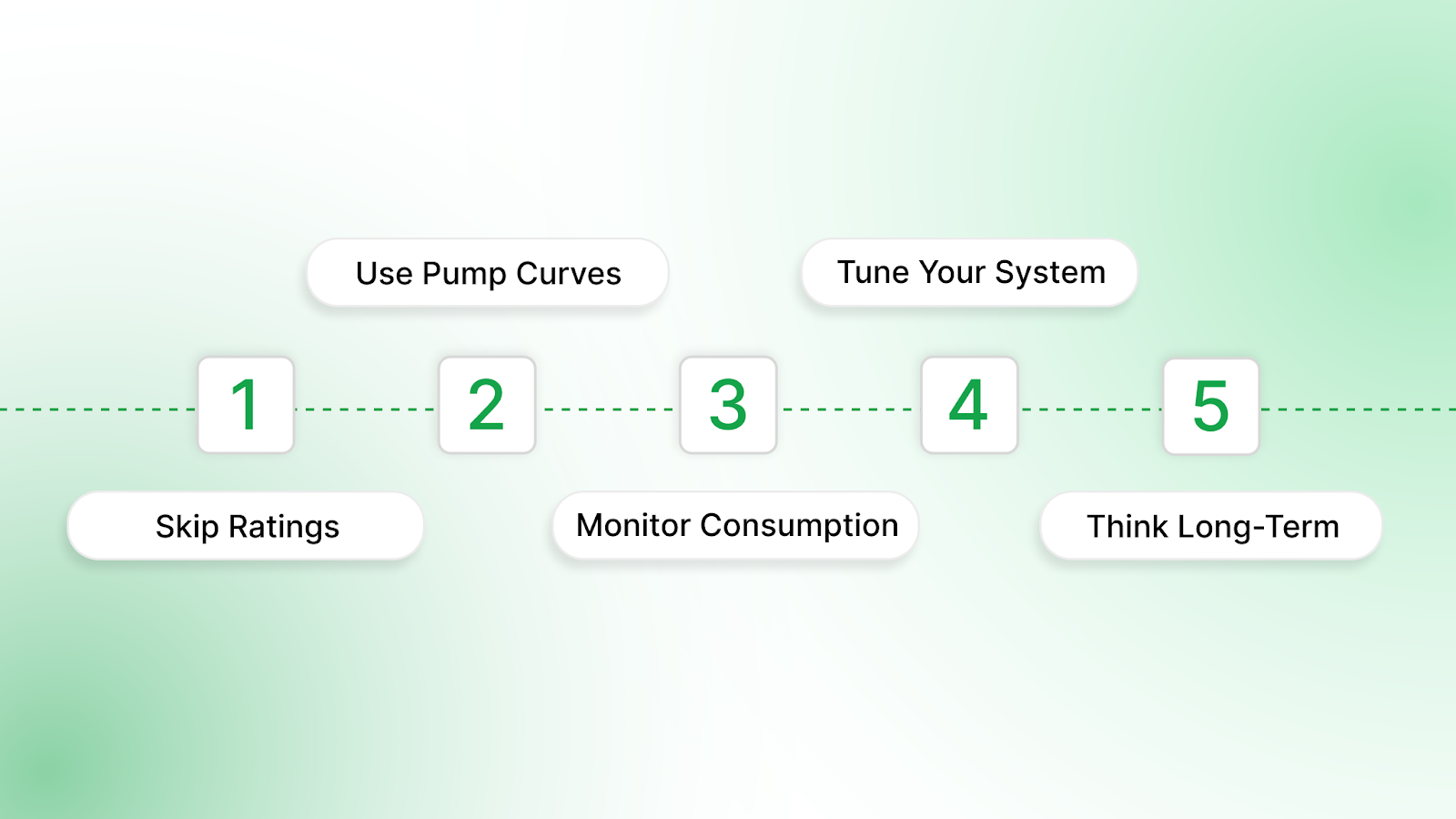
1. Don’t Rely on Nameplate Ratings Alone
Pump and motor specs give you a starting point, but actual performance shifts over time:
- Pipe scaling or clogged filters increase system resistance
- Seasonal temperature or viscosity changes alter flow
- Operator overrides can throw off the balance
2. Use Pump Curves Wisely
Pump performance curves show how flow, head, and efficiency interact. Plot your expected duty point to make sure:
- You’re operating close to the Best Efficiency Point (BEP)
- The motor isn’t overloaded or under-utilized
- You’re avoiding cavitation-prone regions
Quick Tip: Operating far from the BEP leads to energy loss, seal wear, and cavitation risks.
3. Monitor Power Consumption in Real Time
Monthly energy bills aren’t enough. For real savings:
- Install power meters on pump motors
- Pair them with flow meters to track energy per m³
- Set alerts if power increases faster than flow, it’s often an early sign of inefficiency
4. Trim or Tune Your System
Oversized pumps = oversized energy bills. Some fixes:
- Trim the impeller to match the required flow
- Install Variable Frequency Drives (VFDs) to control speed on the fly
- Optimize pipe layout to reduce head losses
5. Think Long-Term, Not Just Day One
A slightly more expensive, energy-efficient pump pays off within months in a 24/7 plant. Always optimize for total lifecycle cost, not just upfront savings.
While optimization strategies are useful in theory, executing them consistently across different plants, fluid types, and operating schedules requires the right tools and partners. That’s where engineering-driven service providers like Chemitek come in.
By combining system diagnostics, pump curve analysis, and energy audits, they help industrial plants go beyond guesswork and ensure every pump is doing its job efficiently, reliably, and within the best efficiency range.
How Chemitek Helps Plants Balance Power and Flow at Scale
Understanding pump performance is one thing; translating it into consistent energy savings and equipment reliability across variable plant conditions is another. That’s where Chemitek steps in.
Chemitek supports industrial plants by addressing common causes of pump inefficiency, including:
- Improper sizing and selection
- Shifting fluid properties across batches
- Lack of real-time performance tracking
- Underuse of pump curve data in decision-making
Chemitek recommends tailored solutions like:
- Impeller trimming to match real-time flow demand
- VFD retrofits for dynamic control
- System tuning to reduce head loss
- Flow-power monitoring for ongoing optimization
Chemitek’s approach is tailored for high-variability sectors like fertilizer, sugar, and chemical manufacturing, where maintaining the right flow-power balance is key to avoiding performance dips and rising energy costs.
Wrapping Up: Don’t Let Flow Speed Sabotage Efficiency
Flow rate and pump power are closely linked but not always in straightforward ways. A slight bump in flow can lead to a steep spike in energy consumption, especially if your system isn’t sized or adjusted correctly.
That’s why monitoring flow alone isn’t enough. You need to track power draw, read pump curves wisely, and account for real-world variables like fluid density shifts or seasonal demand changes.
Whether you’re operating a sugar mill, fertilizer plant, or chemical facility, staying near the pump’s Best Efficiency Point (BEP) can lower energy costs and extend equipment life. And if your conditions fluctuate often, it pays to work with experts.
Chemitek helps you design pump systems that adapt, not just react. From flow tuning to motor selection, we help you reduce energy waste and keep performance stable.
Talk to our specialists today and discover how much efficiency you’re leaving on the table.
FAQs
1. Why does a small increase in flow rate cause a large increase in pump power?
Because pump power increases non-linearly with flow. As flow rises, frictional losses grow, and the pump must work harder, leading to a steeper energy curve.
2. How can I tell if my pump is operating at its Best Efficiency Point (BEP)?
Check your pump curve. If your flow and head intersect near the peak efficiency zone, you’re close to BEP. If not, you may be wasting energy or wearing the pump out.
3. What happens if I oversize or undersize my pump?
Oversizing leads to energy waste and potential system damage. Undersizing results in overheating, frequent breakdowns, and reduced flow performance.
4. How often should I recalculate pump power needs in variable industries like chemical or sugar?
Ideally, after any shift in fluid properties or seasonal load changes. For batch-based processes, review your calculations at least quarterly.
5. Can Chemitek help optimize my current pump setup, or only new installations?
Both. Chemitek specializes in optimizing existing systems through audits, VFD retrofits, impeller trimming, and performance monitoring.
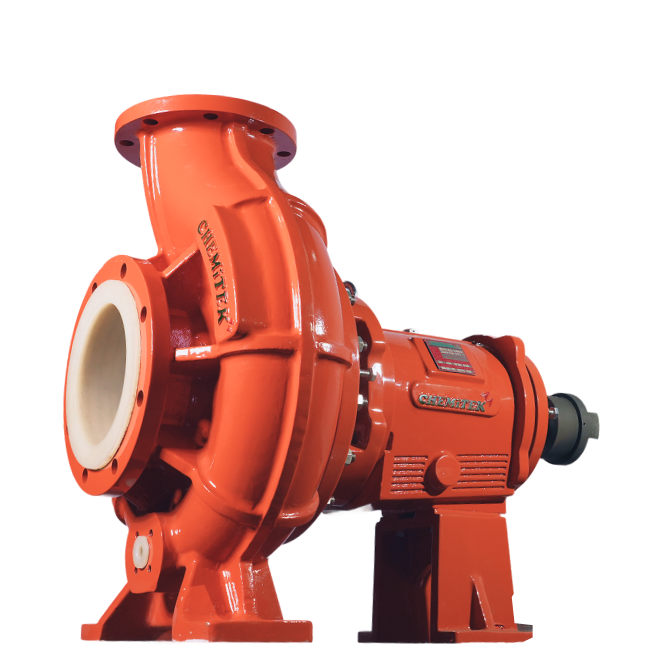
Latest posts
Ready to Upgrade Your Process Operations?
